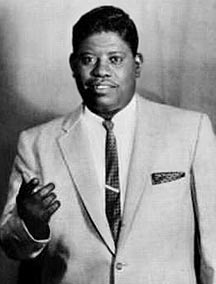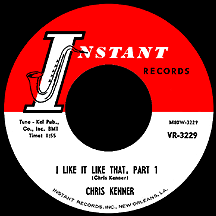CHRIS KENNER
I Like it Like That
I'd like to be able to say that Chris Kenner was one of the most prolific singer-songwriters to come from New Orleans, but that, unfortunately, is not the case. He had his share of personal problems that held him back, but along the way collaborated regardless of vices with some of the city's most talented sons and created at least two songs that have become rock era classics, one of which, the misleadingly-titled "I Like it Like That," is one of the biggest hits ever to originate from the Crescent City.
Chris was born in 1929 and raised in Kenner, Louisiana, some 12 miles west of New Orleans on the Mississippi River. During his teens he lived in the bigger city, worked a variety of jobs in and around the waterfront and sang with gospel group The Harmonising Four before recording his first record, "Grandma's House," released on the Baton label in 1956. He had his first taste of success when he began working with Fats Domino and Dave Bartholomew a year later at Lew Chudd's Imperial label, hitting the charts briefly in August 1957 with "Sick and Tired," a song he had written with help from the other two. Domino later recorded his own similarly-arranged rendition of the song, a top 40 hit in spring 1958 (not the first nor the last time Fats would record one of his own songs after another had hit with it; Roy Brown's "Let the Four Winds Blow" from 1957 a case in point, redone by Fats in '61).
The affiliation between Kenner and Imperial Records was only twice as long as it had been with Baton, which is to say there were two singles released instead of one. The singer's overuse of alcohol and tendency to miss sessions or show up in no condition to perform was at one point cited by Chudd as a reason for terminating the contract. Chris kept plugging away, with the one minor hit (however overshadowed by the much-bigger Domino version) his calling card. One session produced a few songs including "Life is Just a Struggle" (released on the local Ron label), an apt description of what was to come. But things would get better before the long descent, and even then there would be a silver lining of sorts, his knack for writing catchy songs the one saving grace.
The self-penned "I Like it Like That" teamed him for the first time with producer-arranger Allen Toussaint, who played piano on the two-part single and many other Kenner records afterwards. It first appeared in 1960 on Valiant, a subsidiary of Joe Banashak and Larry McKinley's Minit Records, made some noise in New Orleans and was then released nationally on Instant (same owners as Valiant, but renamed to avoid legal hangups). An infectiously straightforward production, the lyrics took a detour from what the title suggested, which may have been an important part of the record's ascension to the million-seller level: 'Come on, let me show you where it's at...the name of the place is I like it like that.' A swingin' joint, no doubt, where '...the last time I was down there I lost my shoes...they had some cat shoutin' the blues...the people was yellin' out for mo', and all they was sayin' was go man go!' If you were around in the summer of 1961, then you may know the song almost as well as your own name, it was that big. The record reached number two on both pop and R&B charts, the year's biggest hit "Tossin' and Turnin'" by Bobby Lewis being the insurmountable obstacle keeping it from going all the way.
Repeating with a record anywhere near as popular as such a massive hit is a difficult task, though he eventually came close (as a writer, though, not a singer). The wild ride did stretch into early 1962, when he received a Grammy nomination for the song in the category of Best Rock and Roll Recording, but by then he'd already felt the frustration a couple of failed singles can bring. The hit's follow-up, "A Very True Story," was a good one, too, the accounting of 'a girl named Kath-a-leen' (who had several quirks, one being that 'opera music gives her the creeps,' and a tendency towards constant dancing that causes her to shake when she talks and wobble when she walks). By my way of thinking it should have been a hit.
All of the Instant 45s from this period were written by Chris, including the third 1961 single on the label, "Something You Got," which failed to make much noise outside New Orleans but became successful through later renditions by Alvin Robinson (another Big Easy native) in summer '64, an instrumental version by The Ramsey Lewis Trio that fall (Ramsey's first, pre-"In Crowd" hit), and finally as a duet by Chuck Jackson and Maxine Brown in the spring of '65. At about the same time, "I Like it Like That" made its return to the top ten by way of The Dave Clark Five, one of many British acts obsessed with the rhythm and blues of their formative years.

Kenner did manage a third chart single of his own, though not a major hit, at least not at the time of its first release in mid-1963. "Land of 1000 Dances" (based on a spiritual tune, "Children Go Where I Send You") started by insisting you '...got to know how to Pony like Bony Moronie' and went on to rattle off a roll call of popular dances, including The Twist, Mashed Potatoes, Watusi, Fly, Hand Jive, Slop, Chicken, Bop, Fish, Tango, Popeye and some 988 others, though most don't manage a mention in the two-and-a-half minute song (he does find time to suggest 'this little place 'cross the track, the name of this place, I like it like that!') The song was made completely of recycled material, and before long would be remade again and again, most notably by East Los Angeles group Cannibal and the Headhunters in 1965 and most successfully by the "wicked" Wilson Pickett in 1966, with versions in between by Thee Midniters (another East L.A. group) and Round Robin (all of them using an added 'na-na-na-na-na' vocal hook). A campy instrumental adaptation of the song even made the charts in 1969 by "Keem-O-Sabe" studio band The Electric Indian.
The enjoyably off-kilter lyrics Chris dreamed up during those years made him ultimately more successful as a songwriter than as a singer, though stylistically his uncomplicated storytelling technique matched the conventional Orleans productions to perfection. The numerous remakes of his four most notable compositions ensured royalty checks would be coming his way for many years. Managing money was not his strong suit; drink usually evaporated whatever he earned, and further failure with a precious few later record releases were offset by his songwriter's earnings. By the late 1960s, Chris spent much of his time passed out in flophouses or curled up on a bench at the downtown bus station...on good days. A lapse in judgment sent him to Louisiana's Angola Penitentiary near the Mississippi border on a statutory rape charge. He served time from 1968 to 1972, after which he spent his remaining years going from bottle to bottle, unable even to attempt any kind of musical comeback.
Chris Kenner had a heart attack and passed away in 1976. He was 46 years old, still in New Orleans, yet many of his former associates might have passed him on the street in those later years without recognition. Some 18 years after Chris died, Jamaican reggae singer Ini Kamoze revived the 'na-na' part from later versions of "Land of 1000 Dances" in "Here Comes the Hotstepper," which hit the top of the charts in December 1994. Kenner's writing credit (along with Fats Domino's, which had been added by that time), posthumously gave him the number one hit he had narrowly missed in 1961 when he was at the top of his game with a classic song about a mythical place across the track that I've always wanted to visit: "I Like it Like That."


